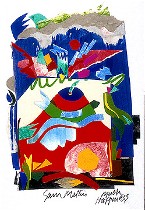
I learned on Christmas Day that Philadelphia artist Sam Maitin had died. He was 76 years old (image, Maitin’s “Much Happiness 2,” collage).
Maitin is scheduled to have three simultaneous shows at the University of Pennsylvania in February, one at the Arthur Ross Gallery, one at Hillel, and one at the Burrison Gallery. A Penn alumnus, Maitin also taught for a time at the Annenberg School for Communication there. He was working on a number of pieces at the time of his death Dec. 23.
His work was collected by museums around the world, including The National Gallery of Art, the Tate, the Philadelphia Museum of Art and MoMA. He spent time in England on a Guggenheim Foundation Fellowship in 1968.
The bright exuberance of his work–prints, collage, paint, murals (there’s one in the Wood Building at the Children’s Hospital of Philadelphia and one at the Annenberg School at Penn) and sculpture–made his work a perennial favorite with public institutions and the public in general. Other public pieces include a dimensional mural at Temple University’s Dental School, outdoor sculpture at George Washington University, and a 70-foot tapestry in China.
Color was the key to his work, said his wife, Lilyan Maitin. Included in his oeuvre, in addition to colorful lithographs, are a number of 5-color wood-block prints.
 His long-time friend, photographer Seymour Mednick, who knew Maitin from their days together as students in the mid-1940s at the Philadelphia Museum School of Industrial Arts, now the University of the Arts, described Maitin as a mensch. He made posters for the Arts Council at the Gershman Y, taught art there, and served on the board at Fleisher Art Memorial for a time (image, “Untitled,” 2003).
His long-time friend, photographer Seymour Mednick, who knew Maitin from their days together as students in the mid-1940s at the Philadelphia Museum School of Industrial Arts, now the University of the Arts, described Maitin as a mensch. He made posters for the Arts Council at the Gershman Y, taught art there, and served on the board at Fleisher Art Memorial for a time (image, “Untitled,” 2003).
When the Greater Philadelphia Cultural Alliance decided to put art in the advertising spaces on bus shelters, Maitin designed the first poster, said Maitin’s daughter, Ani. He involved neighborhood children in creating an outdoor mural on the side of Fleisher Art Memorial. And Bread and Roses Community Fund presents a Maitin print each year for its annual award.
Maitin loved people and loved to talk. His daughter and wife remember all the distinguished visitors who gathered at his house. Artists, writers, photographers from here and abroad, from England and from China, heard about him and came to him seeking his help and his friendship.
His enthusiasm and energy went to a large number of good causes. Among the many projects that threw himself into were rescuing the Louis Kahn archives now at the University of Pennsylvania, saving the facades of a row of historic federalist buildings threatened by demolition and fighting to save the Lucretia Mott housing in Philadelphia’s Society Hill from redevelopment and the residents there from displacement.
At the time of Maitin’s death, he was nearing completion of a piece for the Please Touch Museum, and was working with the architect of a condominium project and recreation center near the airport. All the projects, said his wife, will be completed by the teams of people with whom he had been working.
The funeral was yesterday, a miserable, gray day, said Mednick, who afterwards hunted for a nearby piece of stained glass that Maitin had made for a family, not far from his own burial site. After looking inside a dismal mausoleum and dismissing some dark red-and-blue windows as clearly not Maitins, Mednick went along the back of the building and at the end of a collonade, “there was this shining, sunny stained-glass rectangle. It was astonishing to see anything this cheerful in all this gloom.” A companion piece to that square of stained glass is in the works.
Memorial service plans are still being made.









